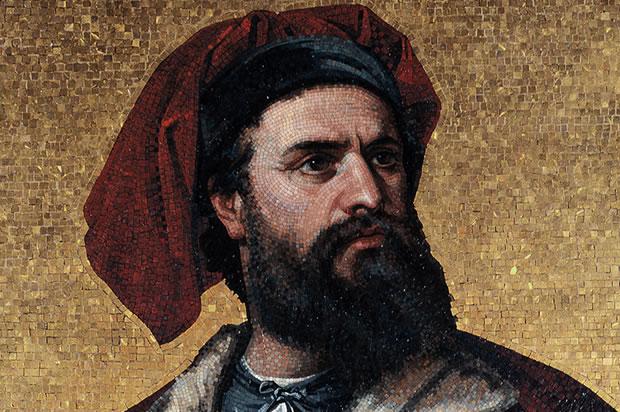As we get ready to mark Marco Polo's death anniversary on January 8, we look at the life and adventures of one of the greatest explorers of all times.
Marco Polo was born in Venice in 1254. He is known for his travelogue “Il Milione” (translated in English as “Book of the Marvels of the World”), where he recounts his travels and experiences through Asia, Persia, China, and Indonesia between 1276 and 1291, introducing that little-known worlds to Europeans of the Middle Ages.
Marco’s adventurous father and uncle
Marco‘s father Niccolò and his brother Maffeo were the first Europeans to gain an audience with the Great Khan. The brothers developed commercial dealings with the East as merchants, trading in jewels. They had liquidated property in 1260, when the political climate was changing in Constantinople, where they were residing, and bought jewels as assets. They met with Kublai Khan in Dadu, now Beijing. He had apparently never met Europeans and, besides asking many questions, he requested that they return and bring him letters from the Pope and 100 learned men versed in the seven arts, as well as oil from the sacred lamp at the Holy Sepulchre in Jerusalem. The brothers left China in 1266 and, three years later, reached Venice. Niccolò met his son Marco for the first time then, when Marco was already 15.

Marco joins the travels
[Image: Marco Polo wearing a Tatar outfit, date of print unknown]
When they were prepared for the return to China in 1269, Marco accompanied them. They had waited two years for a new pontiff to be chosen, after the death of Pope Clement IV in 1268, but were impatient to leave. Already into their journey, they heard that their friend Gregory X had been made pope, so they went back to Acre where they were given two friars to accompany them, along with all the relevant documents to take to China.
In 1271, they travelled to Turkey, and then took four years through Northern Iran, overland, passing through Khorasan (East Iran), overwintering at the foot of the Pamir mountains, crossing extraordinary terrains of valleys, mountains and deserts, including the Valchan (Vocan) Valley, eventually reaching Kashgar (Cascar) and the main Silk Road and then, finally, reaching Sha-Chou and Kansu and the Mongol capital. They had travelled mostly amongst Muslims, but here, the Chinese culture and Buddhism were prevalent. They reached the Mongol court sometime in 1275 and presented the sacred oil from Jerusalem and the papal letters to Kublai Khan. The friars had unfortunately abandoned the journey long before, because of the hardships, and had returned home. There is uncertainty about how long and with what purpose they remained in the Emperor’s domain. Marco was sent on many fact finding missions, such as Yunnan in South West China and Hang-Chou in South East China, and it is widely assumed that he had some business role in the large salt trade.
There came a time when they wanted to return home to Venice. Thus they came to an agreement with the Emperor that they would deliver a certain Mogul princess to Kublai Kahn’s great-nephew Arghun in Persia on route. With fourteen vessels they sailed, stopping over at Sumatra. When they arrived, Arghun had died and they delivered the princess to his son Mahmud Ghazan. It was a perilous two-year journey and many died on route.
From adventurer to prisoner
In 1295, after 24 years away, Marco, his father and uncle arrived in Venice to find that there was a war with Genoa. Marco had to fight in the battle of Cuzola and the Genoans took the day. They also took him prisoner and, for three years, he was incarcerated. He found himself alongside a writer called Rustichello and began relating the stories of his travels, to be written in Franco-Italian dialect.

The writings
[Image: A page from Il Milione, from a manuscript believed to date between 1298–1299]
The original title of the work was Devisement du Monde (Description of the World). Some of the content was controversial and bordered on heresy, as he described various people living where the church had already mapped out there were no inhabitants. It appears that the different translations and edits of the work were altered to protect Marco from the church and others, and much of the writing has questionable embellishments. There are facts which should have been important and were never mentioned, neither the drinking of tea or the Great China Wall (though it is possible that the wall we know as the Great Wall was built later), nor even the idiographic script of the Far East used at the time. However, on the whole, and with much study being undertaken by scholars, it is generally accepted that the mind of the medieval world was enlightened about China and Asia, and that even Columbus was influenced by the work and inspired to undertake his journey.
Marco described Kashgar’s beautiful gardens, Khotan’s rich vineyards and the jade and emerald deposits, the canals of Hangzhou and its prosperity, the salt, sugar, spices and silk, paper money and coal, pearls and diamonds. The work now is under the title Il milione (The Million) and, though an authentic copy of the work doesn’t actually exist, about 140 manuscripts in different languages and dialects have been compiled. The work was constantly written and copied by hand, leaving room for alteration in the days before any printing press.
Marco was released from prison in 1299 and it appears he became a rich merchant. He married Donata Badoer and had three daughters. He died at the age of 70 in 1324, a wealthy man who left a detailed will including funds for the church of San Lorenzo in Venice, where he was buried.

[Image: a miniature from Il Milione]
Marco Polo’s legacy
Besides his travel accounts, a species of sheep that inhabits Central Asia has been named after the explorer, the Marco Polo sheep, as he wrote about these animals he saw in the Pamir Mountains. Venice’s airport is also named after him, Venice Marco Polo Airport. The boat which sailed around the world in less than 6 months was named Marco Polo. Games and shows have adopted his name in honour of his adventures.
Many have said that it is possible that much of the work written was a romantic rendition of memories of his experiences and that he did not personally see everything that he wrote about. The fact remains, however, that through the writings of these travels, the minds in medieval Europe were transported to the exotic and fascinating lands of Asia. The book was popular and widely read - perhaps the most famous travel book in history - and had a great influence on the adventurers and explorers of the day, and represents an important chapter in the history of Italian exploration of the world. Such influence must be attributed as a great treasure for Italy.














